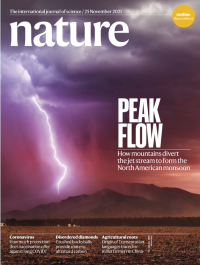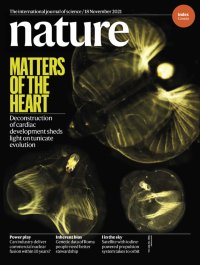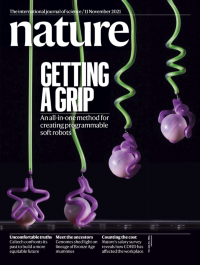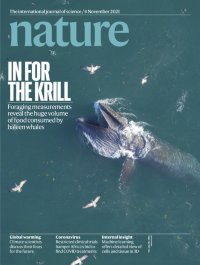Volume 599
-
No. 7886 25 November 2021
Peak flowThe cover shows a lightning strike as a storm in the monsoon moves through the southeastern corner of Arizona. A band of intense rainfall extends for more than 1,000 kilometres along the west coast of Mexico into the southwestern United States during the summer months, constituting the North American monsoon. Monsoons are generally thought to result because land and the ocean are warmed differently by the Sun. This causes changes in air pressure, ultimately creating winds that draw cooler, moist air from the ocean, resulting in rainfall on the land. In this week’s issue, William Boos and Salvatore Pascale show that the North American monsoon is different. Here the monsoon is a result of winds being diverted by mountain ranges. Mexico’s Sierra Madre mountains deflect the jet stream, which in turn lifts up warm moist air and generates convective rainfall. The researchers note that although land heating does occur, its effects are insufficient to explain the monsoon, meaning that the North American monsoon should be thought of as mechanically forced.
Nature Outline
-
No. 7885 18 November 2021
Matters of the heartTunicates, such as sea squirts, are the closest relatives to vertebrates. Most of these marine organisms become sessile — unable to move themselves – when their free-swimming larvae turn into sedentary adults. Appendicularian tunicates, however, do not undergo this transformation and swim freely throughout their lives. The origin of sessility within tunicates and how this relates to appendicularians is the source of much debate. In this week’s issue, Cristian Cañestro and his colleagues offer a fresh perspective on the evolution of tunicates. The researchers focused on heart development in appendicularians and found that their cardiopharyngeal gene regulatory network has been ‘deconstructed’ by massive gene losses. This deconstruction, the team suggests, has contributed to the loss of features that characterized a sessile lifestyle present in the ancestral tunicate. This deconstruction can be connected to evolutionary adaptations that helped appendicularians transition from a sessile to a free-living lifestyle upon the innovation of the ‘house’, a jelly filtration device that characterizes this group of organisms, as shown on the cover.
Nature Index
-
No. 7884 11 November 2021
Getting a gripSoft robots have garnered significant attention in recent years, thanks to their ability to carry out a range of complex tasks such as gripping, crawling or swimming. But making these soft actuators remains a relatively tedious task. In this week’s issue, P.-T. Brun and his colleagues report a bubble-based method for making a variety of actuators based on elastic polymers. Liquid elastomer is first injected into a mould followed by air. This forms an elongated bubble that rises by gravity and sculpts the internal void of the actuator. By varying the template and flow process, various complex architectures are possible, such as artificial muscles and grippers (pictured on the cover).
-
No. 7883 4 November 2021
In for the krillThe cover shows a humpback whale lunge-feeding off Vancouver Island, British Columbia, Canada. Baleen whales such as this consume vast quantities of prey, but finding out exactly how much has proved to be difficult. In this week’s issue, Matthew Savoca and his colleagues use a combination of tracking whale locations and acoustic measurements of prey density to show that consumption of prey is several times larger than previous estimates have suggested. The researchers also calculate that pre-whaling populations in the Southern Ocean consumed 430 million tonnes of Antarctic krill per year, which suggests that whales could accelerate the recycling of nutrients to a degree that might support a radically different ecosystem under higher whale populations.




